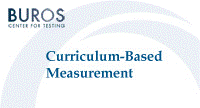Buros-Nebraska Series on Measurement and Testing

Curriculum-Based Measurement
Date of this Version
1993
Document Type
Article
Citation
Curriculum-Based Measurement, edited by Jack J. Kramer (Lincoln, NE: Buros Institute of Mental Measurements, 1993).
Abstract
This volume in the Buros-Nebraska Series on Measurement and Testing provides current information on the development and implementation of curriculum-based measurement. As the title of the volume suggests, effective measurement of children's classroom achievement is not a new problem. Curriculum-based measurement provides an interesting and useful alternative to traditional strategies for assessing academic performance.
This volume continues the tradition of including papers given at the annual Buros-Nebraska Symposium on Testing and Measurement as well as additional contributions selected especially for this book. Each of our authors has made significant contributions to the research that has been produced in the area of curriculum-based measurements.
Stan Deno provides an overview and analysis of curriculum-based measurement (CBM) in the introductory chapter. His paper was presented as the keynote address at the Buros-Nebraska symposium and provides basic information about the manner in which CBM procedures were developed and initially applied to school-based problems. Gerald Tindal analyzes CBM procedures according to nine criteria that have been used to evaluate measurement strategies. This chapter provides a thorough analysis of the technical properties of CBM procedures and a comparison of how CBM relates to other measurement procedures in regard to technical criteria.
Lynn Fuchs demonstrates how CBM can be used to both monitor academic progress and improve instructional programs. Her chapter examines the role of CBM within the larger, more complex instructional environment and she suggests specific applications for practitioners and consultants to consider. Ed Lentz and Jack Kramer look at CBM from the perspective of a behavioral model of assessment. A discussion of the basic tenets of the behavioral model is provided and suggestions for future research in curriculum-based approaches is examined.
Ed Shapiro provides a thorough analysis of the implications of CBM for psycho-educational practice. He makes clear his point of view on the value of the entire range of potential applications of curriculum-based assessment (CBA) procedures, "Use CBA." Finally, Mark Shinn and Roland Good conclude the volume with an assessment of the prognosis for the future of CBM. Their chapter provides a fitting summary of the potential benefits of the CBM approach.
Taken collectively, the contributors represent an impressive group of scholars. Their efforts have defined in large part, the curriculum-based measurement approach. The Buros Institute of Mental Measurements is grateful for their time, efforts, and perseverance in completion of this book.
Included in
Curriculum and Instruction Commons, Educational Assessment, Evaluation, and Research Commons


Comments
Copyright © 1993 by Buros Institute of Mental Measurements. Digital Edition Copyright © 2012 Buros Center for Testing. This book may be downloaded, saved, and printed by an individual for their own use. No part of this book may be re-published, re-posted, or redistributed without written permission of the holder of copyright.